Yusong Wu
ReaLJam: Real-Time Human-AI Music Jamming with Reinforcement Learning-Tuned Transformers
Feb 28, 2025Abstract:Recent advances in generative artificial intelligence (AI) have created models capable of high-quality musical content generation. However, little consideration is given to how to use these models for real-time or cooperative jamming musical applications because of crucial required features: low latency, the ability to communicate planned actions, and the ability to adapt to user input in real-time. To support these needs, we introduce ReaLJam, an interface and protocol for live musical jamming sessions between a human and a Transformer-based AI agent trained with reinforcement learning. We enable real-time interactions using the concept of anticipation, where the agent continually predicts how the performance will unfold and visually conveys its plan to the user. We conduct a user study where experienced musicians jam in real-time with the agent through ReaLJam. Our results demonstrate that ReaLJam enables enjoyable and musically interesting sessions, and we uncover important takeaways for future work.
Hierarchical Generative Modeling of Melodic Vocal Contours in Hindustani Classical Music
Aug 26, 2024Abstract:Hindustani music is a performance-driven oral tradition that exhibits the rendition of rich melodic patterns. In this paper, we focus on generative modeling of singers' vocal melodies extracted from audio recordings, as the voice is musically prominent within the tradition. Prior generative work in Hindustani music models melodies as coarse discrete symbols which fails to capture the rich expressive melodic intricacies of singing. Thus, we propose to use a finely quantized pitch contour, as an intermediate representation for hierarchical audio modeling. We propose GaMaDHaNi, a modular two-level hierarchy, consisting of a generative model on pitch contours, and a pitch contour to audio synthesis model. We compare our approach to non-hierarchical audio models and hierarchical models that use a self-supervised intermediate representation, through a listening test and qualitative analysis. We also evaluate audio model's ability to faithfully represent the pitch contour input using Pearson correlation coefficient. By using pitch contours as an intermediate representation, we show that our model may be better equipped to listen and respond to musicians in a human-AI collaborative setting by highlighting two potential interaction use cases (1) primed generation, and (2) coarse pitch conditioning.
The Song Describer Dataset: a Corpus of Audio Captions for Music-and-Language Evaluation
Nov 22, 2023



Abstract:We introduce the Song Describer dataset (SDD), a new crowdsourced corpus of high-quality audio-caption pairs, designed for the evaluation of music-and-language models. The dataset consists of 1.1k human-written natural language descriptions of 706 music recordings, all publicly accessible and released under Creative Common licenses. To showcase the use of our dataset, we benchmark popular models on three key music-and-language tasks (music captioning, text-to-music generation and music-language retrieval). Our experiments highlight the importance of cross-dataset evaluation and offer insights into how researchers can use SDD to gain a broader understanding of model performance.
MusicLDM: Enhancing Novelty in Text-to-Music Generation Using Beat-Synchronous Mixup Strategies
Aug 03, 2023



Abstract:Diffusion models have shown promising results in cross-modal generation tasks, including text-to-image and text-to-audio generation. However, generating music, as a special type of audio, presents unique challenges due to limited availability of music data and sensitive issues related to copyright and plagiarism. In this paper, to tackle these challenges, we first construct a state-of-the-art text-to-music model, MusicLDM, that adapts Stable Diffusion and AudioLDM architectures to the music domain. We achieve this by retraining the contrastive language-audio pretraining model (CLAP) and the Hifi-GAN vocoder, as components of MusicLDM, on a collection of music data samples. Then, to address the limitations of training data and to avoid plagiarism, we leverage a beat tracking model and propose two different mixup strategies for data augmentation: beat-synchronous audio mixup and beat-synchronous latent mixup, which recombine training audio directly or via a latent embeddings space, respectively. Such mixup strategies encourage the model to interpolate between musical training samples and generate new music within the convex hull of the training data, making the generated music more diverse while still staying faithful to the corresponding style. In addition to popular evaluation metrics, we design several new evaluation metrics based on CLAP score to demonstrate that our proposed MusicLDM and beat-synchronous mixup strategies improve both the quality and novelty of generated music, as well as the correspondence between input text and generated music.
Large-scale Contrastive Language-Audio Pretraining with Feature Fusion and Keyword-to-Caption Augmentation
Nov 12, 2022Abstract:Contrastive learning has shown remarkable success in the field of multimodal representation learning. In this paper, we propose a pipeline of contrastive language-audio pretraining to develop an audio representation by combining audio data with natural language descriptions. To accomplish this target, we first release LAION-Audio-630K, a large collection of 633,526 audio-text pairs from different data sources. Second, we construct a contrastive language-audio pretraining model by considering different audio encoders and text encoders. We incorporate the feature fusion mechanism and keyword-to-caption augmentation into the model design to further enable the model to process audio inputs of variable lengths and enhance the performance. Third, we perform comprehensive experiments to evaluate our model across three tasks: text-to-audio retrieval, zero-shot audio classification, and supervised audio classification. The results demonstrate that our model achieves superior performance in text-to-audio retrieval task. In audio classification tasks, the model achieves state-of-the-art performance in the zero-shot setting and is able to obtain performance comparable to models' results in the non-zero-shot setting. LAION-Audio-630K and the proposed model are both available to the public.
The Chamber Ensemble Generator: Limitless High-Quality MIR Data via Generative Modeling
Sep 28, 2022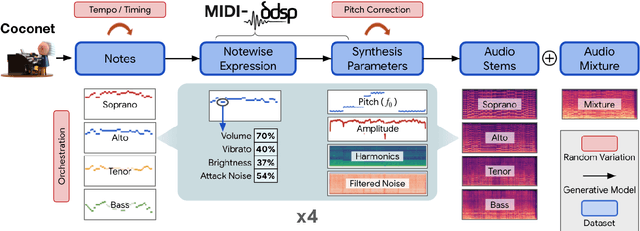
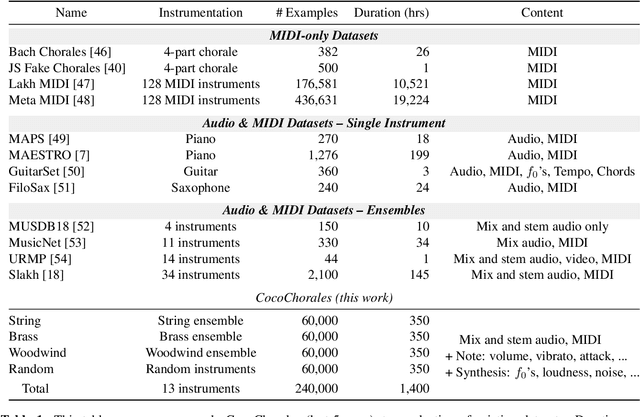
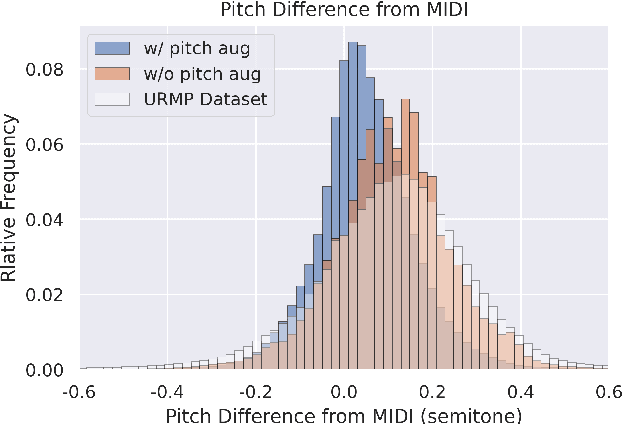

Abstract:Data is the lifeblood of modern machine learning systems, including for those in Music Information Retrieval (MIR). However, MIR has long been mired by small datasets and unreliable labels. In this work, we propose to break this bottleneck using generative modeling. By pipelining a generative model of notes (Coconet trained on Bach Chorales) with a structured synthesis model of chamber ensembles (MIDI-DDSP trained on URMP), we demonstrate a system capable of producing unlimited amounts of realistic chorale music with rich annotations including mixes, stems, MIDI, note-level performance attributes (staccato, vibrato, etc.), and even fine-grained synthesis parameters (pitch, amplitude, etc.). We call this system the Chamber Ensemble Generator (CEG), and use it to generate a large dataset of chorales from four different chamber ensembles (CocoChorales). We demonstrate that data generated using our approach improves state-of-the-art models for music transcription and source separation, and we release both the system and the dataset as an open-source foundation for future work in the MIR community.
MIDI-DDSP: Detailed Control of Musical Performance via Hierarchical Modeling
Dec 17, 2021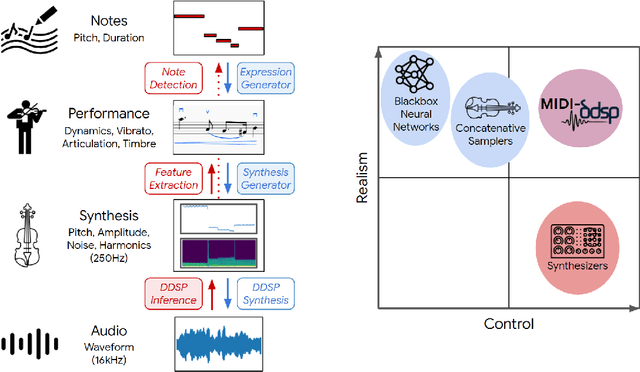
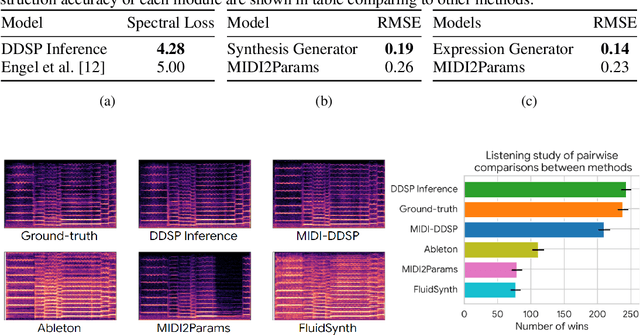
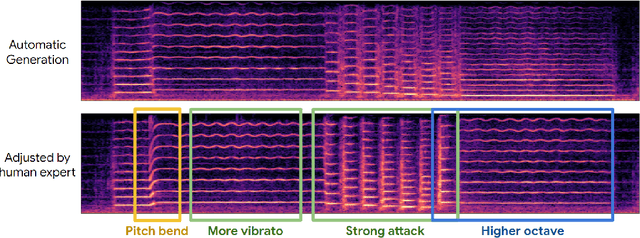

Abstract:Musical expression requires control of both what notes are played, and how they are performed. Conventional audio synthesizers provide detailed expressive controls, but at the cost of realism. Black-box neural audio synthesis and concatenative samplers can produce realistic audio, but have few mechanisms for control. In this work, we introduce MIDI-DDSP a hierarchical model of musical instruments that enables both realistic neural audio synthesis and detailed user control. Starting from interpretable Differentiable Digital Signal Processing (DDSP) synthesis parameters, we infer musical notes and high-level properties of their expressive performance (such as timbre, vibrato, dynamics, and articulation). This creates a 3-level hierarchy (notes, performance, synthesis) that affords individuals the option to intervene at each level, or utilize trained priors (performance given notes, synthesis given performance) for creative assistance. Through quantitative experiments and listening tests, we demonstrate that this hierarchy can reconstruct high-fidelity audio, accurately predict performance attributes for a note sequence, independently manipulate the attributes of a given performance, and as a complete system, generate realistic audio from a novel note sequence. By utilizing an interpretable hierarchy, with multiple levels of granularity, MIDI-DDSP opens the door to assistive tools to empower individuals across a diverse range of musical experience.
An Encoder-Decoder Based Audio Captioning System With Transfer and Reinforcement Learning
Aug 05, 2021



Abstract:Automated audio captioning aims to use natural language to describe the content of audio data. This paper presents an audio captioning system with an encoder-decoder architecture, where the decoder predicts words based on audio features extracted by the encoder. To improve the proposed system, transfer learning from either an upstream audio-related task or a large in-domain dataset is introduced to mitigate the problem induced by data scarcity. Besides, evaluation metrics are incorporated into the optimization of the model with reinforcement learning, which helps address the problem of ``exposure bias'' induced by ``teacher forcing'' training strategy and the mismatch between the evaluation metrics and the loss function. The resulting system was ranked 3rd in DCASE 2021 Task 6. Ablation studies are carried out to investigate how much each element in the proposed system can contribute to final performance. The results show that the proposed techniques significantly improve the scores of the evaluation metrics, however, reinforcement learning may impact adversely on the quality of the generated captions.
Peking Opera Synthesis via Duration Informed Attention Network
Aug 07, 2020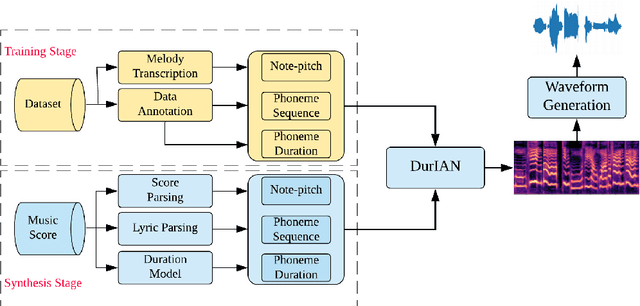
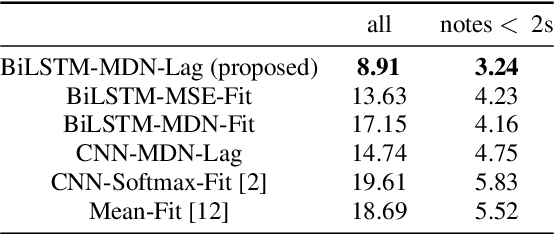
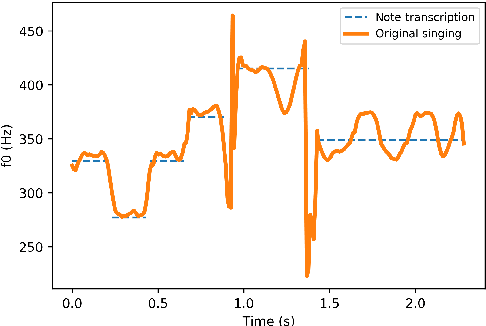
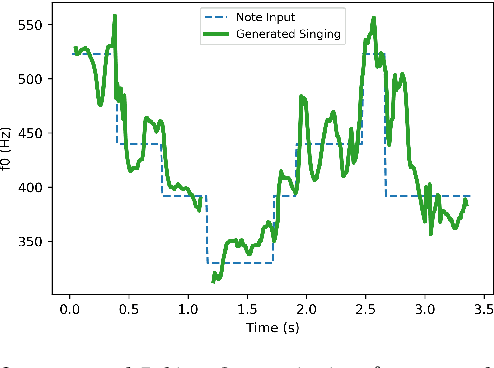
Abstract:Peking Opera has been the most dominant form of Chinese performing art since around 200 years ago. A Peking Opera singer usually exhibits a very strong personal style via introducing improvisation and expressiveness on stage which leads the actual rhythm and pitch contour to deviate significantly from the original music score. This inconsistency poses a great challenge in Peking Opera singing voice synthesis from a music score. In this work, we propose to deal with this issue and synthesize expressive Peking Opera singing from the music score based on the Duration Informed Attention Network (DurIAN) framework. To tackle the rhythm mismatch, Lagrange multiplier is used to find the optimal output phoneme duration sequence with the constraint of the given note duration from music score. As for the pitch contour mismatch, instead of directly inferring from music score, we adopt a pseudo music score generated from the real singing and feed it as input during training. The experiments demonstrate that with the proposed system we can synthesize Peking Opera singing voice with high-quality timbre, pitch and expressiveness.
Synthesising Expressiveness in Peking Opera via Duration Informed Attention Network
Dec 27, 2019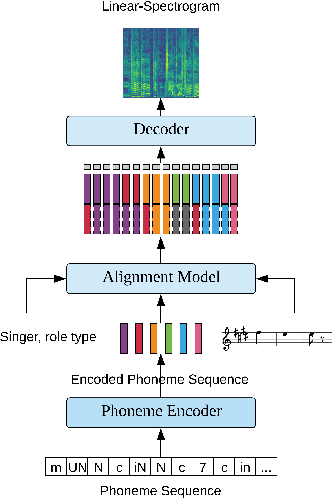

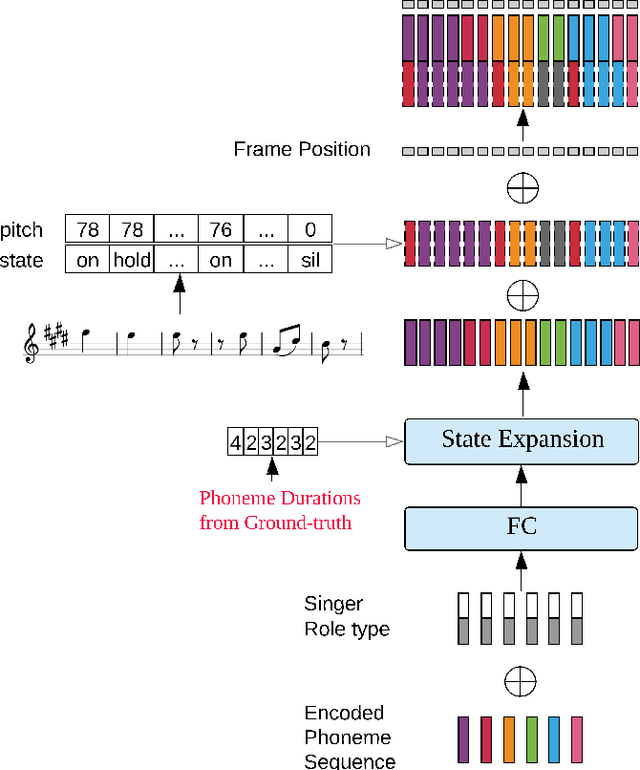
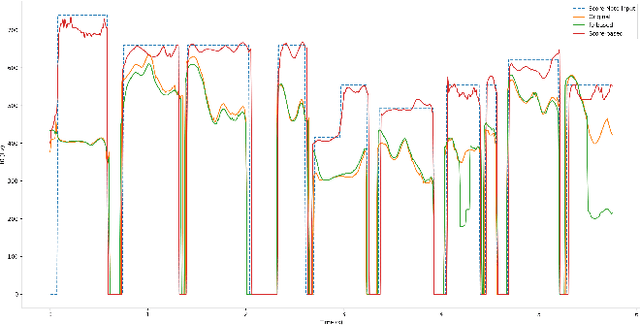
Abstract:This paper presents a method that generates expressive singing voice of Peking opera. The synthesis of expressive opera singing usually requires pitch contours to be extracted as the training data, which relies on techniques and is not able to be manually labeled. With the Duration Informed Attention Network (DurIAN), this paper makes use of musical note instead of pitch contours for expressive opera singing synthesis. The proposed method enables human annotation being combined with automatic extracted features to be used as training data thus the proposed method gives extra flexibility in data collection for Peking opera singing synthesis. Comparing with the expressive singing voice of Peking opera synthesised by pitch contour based system, the proposed musical note based system produces comparable singing voice in Peking opera with expressiveness in various aspects.
 Add to Chrome
Add to Chrome Add to Firefox
Add to Firefox Add to Edge
Add to Edge